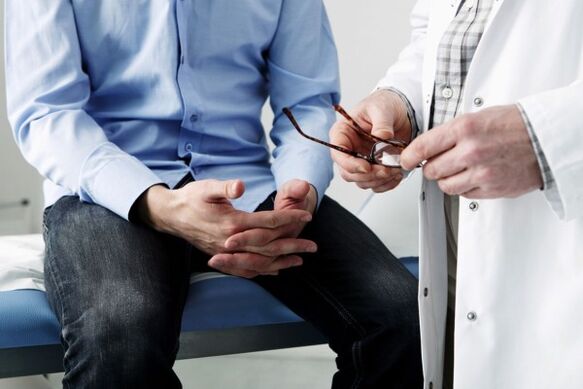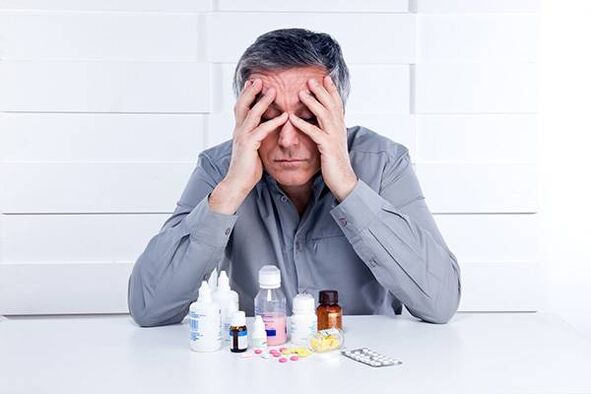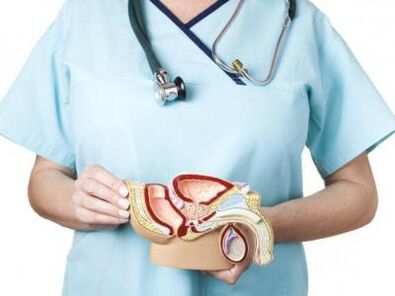Prostatitis is one of the most common urological diseases in men. And that is impressive even in the background of the fact that the actual number of patients suffering from this disease is much higher than the registered statistics. This is explained by the fact that prostatitis can occur in a latent state and the peculiarities of the diagnosis.
What does the prostate look like?
%20in%20men.jpg)
It is a glandular-muscular organ of small size. Localized in the pelvic region below the bladder, it captures the initial part of the urethra.
The function of the gland is to produce a secretion that maintains the vitality of sperm in various unfavorable conditions, mixing with semen.
What is the prostate in men? Prostatitis is characterized by a number of disorders associated with urinary system, erectile function, decreased libido and other problems.
The lack of timely and correct treatment is fraught with sad consequences: every fourth patient can get one or another form of infertility, because the prostate loses the ability to produce the necessary amount of reliable secretion to ensure sperm motility.
Recognizable symptoms of prostatitis in men can be present not only in this disease, but also in prostate adenoma, a malignant tumor!
Signs
What can be the first "bell" of disease? The variability of manifestations complicates the diagnosis, so it is not always possible to immediately determine the presence of the disease. Bacterial prostatitis in its initial symptoms differs from the type of viral origin, such differences are characteristic of the acute and chronic course of the disease.
At the same time, there are the main symptoms that should attract the patient's attention:
- Problems urinating. It gets hard and painful. This may indicate the initial symptoms of exacerbation. The reason lies in the obstruction of the urethra with an inflamed and enlarged prostate. Failure to take timely measures leads to deterioration of well-being due to complete closure of the ureter.
- Sexual disorders. They are characterized by weakening of orgasm and erection.
The mentioned disorders related to this disease are by no means the only ones, but they can be only one of the first signals of exacerbation.
In addition to them, the following signs are present:
- urethral discharge;
- floating threads in urine;
- specific sensations during bowel movements;
- uncomfortable burning sensation in the perineum.
Diversity is a characteristic feature of this disease. Therefore, it is necessary to distinguish the first symptoms of prostatitis in men of chronic bacterial form from acute.
The causes of prostatitis in men lie in a sedentary lifestyle, colds of the genitourinary system.
Characteristics of different forms of prostatitis
The disease can occur in the four most common forms.
Acute bacterial. It is usually diagnosed in patients under the age of thirty. The disease is characterized by fever - the temperature with prostatitis is up to 38 C and above.

As a result of prostate edema, the following is observed:
- acute retention, as well as frequency and pain when urinating;
- prolonged discharge;
- discomfort in the groin area;
- erectile dysfunction.
Symptoms of sudden prostatitis sometimes include general weakness, apathy.
Chronic bacterial. This form is typical for elderly patients. The disease progresses more calmly, however, it can get worse if there are factors that contribute to it. Sometimes the disease is asymptomatic.
Non-bacterial. Although it is not possible to detect the presence of bacteria, this circumstance does not exclude their presence.
Prostatodynia. It is characterized by compaction of prostate tissue without inflammatory symptoms in it.
How to determine
Before effective treatment can be prescribed, the disease must be identified.

An integrated approach is important in diagnostics:
- Collection of anamnesis. To get a reliable picture of the course of the disease, the doctor reveals: the nature of the pain, the presence of discharge, problems of a sexual nature. Rectal analysis of the fingers is performed, with the help of which the degree of swelling and pain of the prostate is revealed.
- Laboratory research. It is often impossible to identify the disease without them. This is especially true of chronic bacterial prostatitis. To find out the reason, a urine culture is prescribed, which helps determine the pathogen that contributes to the worsening. Three urine samples are compared for reliability. Sometimes a biopsy and discharge analysis may be needed. Venous blood is also analyzed for ESR content and leukocyte count.
- Ultrasonography. Tomography (computed tomography and magnetic resonance imaging). These studies are conducted in relation to the prostate and adjacent organs.
How it is treated
Bitan! Medications are prescribed by a urologist. You can't do "self-naming" - it will only make the disease worse!
Modern ways of treating the disease in men are diverse. You can completely cure your prostate if you see a doctor in time.
The choice of forms and methods is in accordance with the degree of complexity, the time of onset of the disease, the well-being of the patient and the characteristics of his body.
The appointment of procedures, which can be performed on an outpatient basis or in a hospital, also depends on this.
The treatment regimens of acute and chronic prostatitis in the exacerbation phase are practically similar. With timely and adequate treatment, the acute form is completely cured, the chronic one achieves long-term remission.
Bitan! The disease wins only with an integrated approach to treatment - do not ignore the advice of a doctor!
Drug therapy
Drug treatment consists of taking antibiotics, nonsteroidal painkillers, alpha blockers. The former are generally used to treat the bacterial form.

In the chronic course of the disease, alpha-blockers are prescribed to reduce prostate edema and relieve pain.
Bitan! It is recommended to use the tablets during the entire course, which usually lasts at least six months, and not to stop earlier, even when you feel better.
Non-steroidal anti-inflammatory drugs - for the treatment of acute forms.
Massage

It is considered an effective treatment. Improves the blood supply to the glandular tissue, when used in combination with other methods of treatment, greatly increases the effectiveness of antibacterial and topical therapy.
Thanks to digital stimulation, it accelerates the secretion of secretions from the prostate, which facilitates further self-excretion through the urethra.
Despite the fact that patients often feel discomfort from the procedure, neglecting massage is not recommended.
Attention! It is forbidden to use massage procedures in case of an acute form of the disease - it is overwhelmed by the spread of the infection!
Reflexology
With the help of acupuncture and other methods, the work of the central nervous system is improved, blood flow and metabolic processes in the body are normalized. Reflexology helps relieve neuralgic pain, prevents the development of inflammatory processes. It is recommended that this procedure be performed in combination with other treatment methods.
Hirudotherapy
This method is also used in the treatment of prostatitis. The use of leeches helps to increase the flow of blood and lymph in the prostate and normalize its work.
Rectal suppositories
They directly affect the focus of the lesion, so they are a very effective remedy. Antispasmodics, anabolic steroids, antibacterial substances contained in them are good for the prevention of exacerbations.
The effect of ichthyol and sea buckthorn suppositories is high.
Immunological correction
Anyone suffering from this disease is advised to strengthen the immune system. This helps to increase the body's resistance, helps to slow down the development of exacerbations of chronic prostatitis. The complex should use:
- natural methods - active physical exercise, walking in the fresh air, hardening;
- natural immunomodulators - ginseng, echinacea and others;
- multivitamin complexes.
Surgical intervention
At one time, they often resorted to the surgical method of treatment. However, in some cases this did not bring high efficiency. In recent years, surgical manipulations have been mainly used for prostate abscesses or urethral narrowing.
Thirty years is already a reason to think about your health. Among patients who have crossed this age limit, every third suffers from prostatitis, and after the age of 50 - every second. And this trend continues to this day.
Now that you know the first signs of prostatitis in men and its treatment, in order to avoid the disease and further transition to a chronic form, it is necessary to see a doctor regularly for timely detection. Every patient should know what to do with prostatitis and where to go.






























